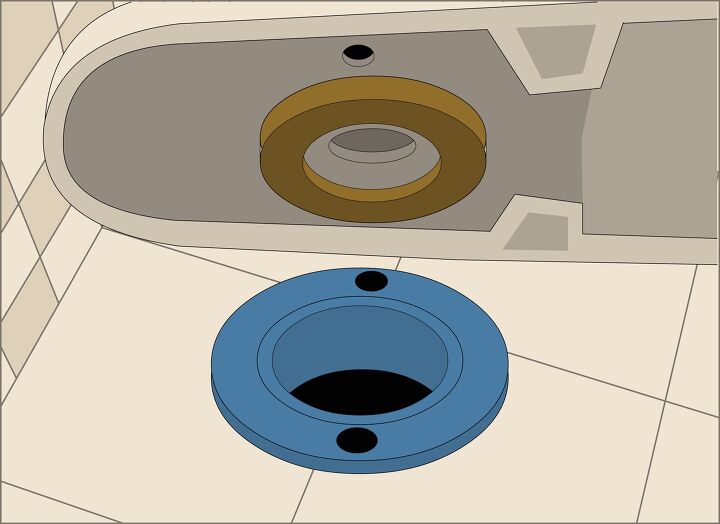6 Types Of Toilet Flanges (With Photos)

It is easy to overlook toilet flanges, but they are just as important as the drainpipe itself. A toilet flange connects the toilet to the drainpipe in the floor or subfloor. So, what are the main types of toilet flanges?
Copper, brass, and PVC toilet flanges are the most common options because they are durable and affordable. Stainless steel toilet flanges are popular, but the entire flange is rarely made of steel. Cast iron and aluminum toilet flanges are durable but are prone to rust and corrosion over time.
You can only use cast iron toilet flanges if you have a cast iron drainpipe. Toilet flanges come in several sizes that vary based on your drainpipe connection. Follow along as we explore the most common types of toilet flanges.
Do You Need to Install or Repair a Toilet?
Get free, zero-commitment quotes from pro contractors near you.

Types of Toilet Flanges
There are six main types of toilet flanges to choose from, categorized based on the material that they are made out of:
1. Copper
Copper toilet flanges are popular because they can resist corrosion. This means that copper toilet flanges can hold up better than brass or stainless steel flanges. Copper flanges come in soft and rigid varieties that work the same way but have a different consistency.
It is easier to install soft copper flanges because they are flexible and don’t require elbow joints. Rigid copper toilet flanges require elbow joints to secure them and they are harder to install. Both varieties are biostatic which means that they are anti-fungal and anti-bacterial.
2. Brass
Brass toilet flanges are among the most durable options because of their unique alloy makeup. They are made of an alloy of both copper and zinc which makes brass toilet flanges strong. The heat resistance and durability of brass toilet flanges are why many homeowners choose them.
The only downside to brass toilet flanges is that they are heavy and can oxidize. Air exposure can cause brass toilet flanges to oxidize and eventually weaken. These toilet flanges also come in a variety of sizes and shapes, including regular, deep seal, and offset sizing
3. Plastic (PVC)
Polyvinyl chloride (PVC) toilet flanges are the most common option on the market. They are affordable, easy to install, and readily available at most hardware stores. You don’t have to worry about rust and erosion with PVC toilet flanges.
Many PVC toilet flanges feature metal tops, but that is the only part that is prone to rust. They are versatile and PVC toilet flanges can fit 3” and 4” drainpipes. Unfortunately, PVC toilet flanges cannot withstand high pressure and are less durable than copper or brass alternatives.
One alternative to PVC is known as ABS plastic, which is just as lightweight, but even more durable. Although ABS plastic usually costs more than PVC, it can withstand more robust waste and running water.
4. Stainless Steel
Stainless steel flanges are misleading because only the wax ring is made out of stainless steel. Typically, the rest of the flange is made of PVC, brass, or copper depending on the brand. The wax ring is generally made of 304 stainless steel which is 8% nickel and 18% chromium.
You can improve the stability of stainless steel toilet flanges if you add silicone to them. This will help minimize the risk of rust and oxidation. Stainless steel toilet flanges have a superior seal to PVC flanges.
5. Cast Iron
You can only use cast iron toilet flanges if you have a copper drainpipe. The durability that cast iron toilet flanges provide is unparalleled. Homeowners install cast iron toilet flanges when the drainpipe is beneath the subfloor.
Expect to spend between $13 and $35 for a cast iron toilet flange. This may seem expensive for a toilet flange, but that is because cast iron is a dense and pricey material. Cast iron can rust and oxidize more quickly than other metals, such as brass and copper.
6. Aluminum
Aluminum is often used for the wax ring of toilet flanges, but some flanges are made entirely of aluminum. Toilet flanges made of aluminum are not as durable as brass, copper, or even PVC in some cases. However, they are readily available, easy to install, and can resist corrosion.
Toilet Flange Sizes
In addition to material, toilet flanges can also be categorized based on size. The size depends on their shape and diameter. Let’s take a look.
Toilet Flange Shapes
The three primary shapes that are used in the design of a toilet flange are as follows:
- Regular: These flanges are designed to fit around and inside the opening of a drain pipe. They have the smallest depth, only going into the pipe approximately five inches, or so.
- Deep Seal: As the name suggests, deep seal flanges extend into the pipe deeper than their regular counterparts – roughly 12 inches deeper.
- Offset: These shaped flanges are ideal for oddly positioned openings like when the pipe opening is too close to the wall or far from the floor. They include an elbow for easy installation and adjustment of the flange, which is located inches away.
Toilet Flange Diameters
Toilet flanges can be installed into or over the drain pipe. For this reason, there are only two toilet flange diameters to choose from: four- and three-inch.
Standard 4×3 Flanges
Standard 4×3 toilet flanges are a common size that fits most toilets and are widely available in most plumbing, hardware, or home improvement stores. The 4×3 describes two diameters, the component that connects to the toilet (four inches) and the bottom diameter that fits to the drain pipe (three inches). The difference is where the three-inch base diameter is designed to pair with a 40 pipe, used in most homes as the standard size for drain pipes.
3-inch Flanges
These types of flanges simply indicate that the diameter of the top and bottom area is both three inches. Although these are the easiest option to install, you want to ensure that your piping is sized correctly. If you don’t have a three-inch pipe, consider opting for a different toilet flange is a three-inch flange may offset the alignment of the plumbing.
You can also find four-inch flanges that have four-inch diameters on the top and bottom. Though, these are much rarer compared to the three-inch toilet flanges.
Odd Sized Flanges
Aside from the two main flange diameters, there are oddly sized flanges that measure smaller or bigger than the standard 4×3 toilet flange. A common example is an ABS plastic flange that has a seven-inch top diameter and a 3 1/2-inch base diameter. These flanges will require extension kits to raise the height of the flange enough to fit the requirements of the installation.
Other oddly sized flanges feature a diagonal set offering extra space, particularly for elongated toilets that replace a round toilet. This requires an extension.
Do You Need to Install or Repair a Toilet?
Get free, zero-commitment quotes from pro contractors near you.

When to Replace Toilet Flange
It can be hard to tell if your toilet flange is broken, as it is out of view underneath the toilet. However, there are some signs and symptoms that may indicate a problem with your flange. Here are the symptoms that you should keep an eye out for:
- Leaking from the bottom of your toilet. If your toilet starts to leak from the base, this is likely caused by an issue with the flange. It may be either a crack in the flange or the flange may be the wrong size for your toilet.
- Your toilet moves back and forth. If your toilet wiggles or rocks back and forth, this is a strong indication of a problem with the flange.
- Your bathroom has a sewer smell. Rotten or sulfuric odors in your bathroom without a leak may mean that the flange is broken just enough to allow the smell to enter your bathroom.
Familiarizing yourself with these common symptoms can help you stay on top of problems and replace your toilet flange accordingly.
Related Guides

Jessica considers herself a home improvement and design enthusiast. She grew up surrounded by constant home improvement projects and owes most of what she knows to helping her dad renovate her childhood home. Being a Los Angeles resident, Jessica spends a lot of her time looking for her next DIY project and sharing her love for home design.
More by Jessica Stone































